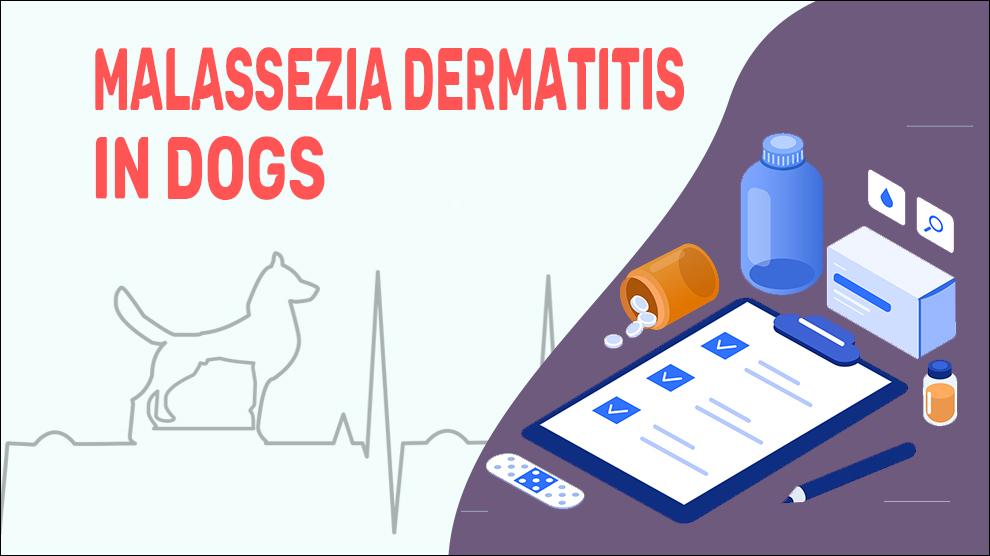What Is Malassezia Dermatitis In Dogs?
Malassezia dermatitis is a fungal infection that commonly affects dogs. The symptoms include itching, redness, and scaling of the skin, especially in areas such as the ears, paws, and folds of the skin.
It is caused by an overgrowth of the Malassezia yeast, which is normally found on the skin in small amounts. Certain dog breeds, such as West Highland white terriers and Basset hounds, are more prone to developing this condition.
With proper diagnosis and treatment, as well as preventive measures such as regular grooming and maintenance, this condition can be managed effectively.
Symptoms Of Malassezia Dermatitis In Dogs
The symptoms of Malassezia dermatitis in dogs can vary depending on the severity of the condition.
Some common symptoms include:
- Redness and inflammation of the skin
- Itching and scratching
- Scaling or flaking of the skin
- Greasy or oily patches on the skin
- Discharge or odor from the affected areas
- Thickening of the skin
- Hair loss or bald patches
In severe cases, the skin may become infected, leading to secondary bacterial or fungal infections.
Treatment Options For Malassezia Dermatitis In Dogs
The treatment of Malassezia dermatitis in dogs usually involves a combination of topical and systemic medications, as well as changes to the dog's environment and grooming routine.
Topical treatments may include medicated shampoos, creams, or sprays that are designed to kill the yeast and soothe the skin. These may contain ingredients such as antifungal agents, antibacterial agents, or anti-inflammatory agents.
Systemic treatments may include oral medications such as antifungal drugs or steroids, which are designed to target the yeast and reduce inflammation.
In addition to medications, it is important to make changes to the dog's environment and grooming routine in order to prevent the overgrowth of Malassezia pachydermatis.
This may include bathing the dog regularly with a medicated shampoo, keeping the skin dry and clean, and avoiding exposure to allergens or other irritants.
Home Remedies For Malassezia Dermatitis In Dogs
While there are no specific home remedies for Malassezia dermatitis, there are some things that owners can do to help soothe their dog's skin and promote healing.
These may include:
- Giving the dog regular baths with a mild, hypoallergenic shampoo
- Using a gentle, non-irritating moisturizer to keep the skin hydrated
- Applying a cool compress or ice pack to soothe itching and inflammation
- Adding supplements to the dog's diet that may help support the immune system and improve skin health, such as omega-3 fatty acids or probiotics
How To Prevent Malassezia Dermatitis In Dogs?
Preventing Malassezia dermatitis in dogs involves maintaining good skin hygiene and addressing any underlying health conditions that may contribute to the overgrowth of yeast.
This may include:
- Bathing the dog regularly with a mild, hypoallergenic shampoo
- Keeping the dog's skin dry and clean
- Addressing any underlying allergies or hormonal imbalances
- Avoiding exposure to potential irritants, such as certain foods or chemicals
- Regular veterinary check-ups to monitor the dog's skin health
Affected Dog Breeds Of Malassezia Dermatitis
Some of the dog breeds that are more prone to developing Malassezia dermatitis include Basset Hounds, Cocker Spaniels, West Highland White Terriers, and Shar Peis.
These breeds tend to have more skin folds or hair growth in the ears and other areas that trap moisture, which can promote the overgrowth of the Malassezia yeast.
Causes For Malassezia Dermatitis In Dogs
Causes:
Malassezia dermatitis is caused by an overgrowth of Malassezia pachydermatis, which is a yeast that normally lives on the skin of dogs.
In healthy dogs, this yeast is kept in check by the immune system and other beneficial bacteria on the skin.
However, in some dogs, the immune system may be weakened by underlying health conditions, such as allergies or hormonal imbalances, allowing the yeast to grow unchecked.
Other factors that can contribute to the development of Malassezia dermatitis include poor grooming habits, underlying skin conditions such as seborrheic dermatitis, and certain medications that can suppress the immune system.
When To See A Vet For Malassezia Dermatitis In Dogs?
If you suspect that your dog may be suffering from Malassezia dermatitis, it is important to seek veterinary care as soon as possible.
A veterinarian will be able to properly diagnose the condition and recommend an appropriate treatment plan.
Some of the common signs of Malassezia dermatitis include itching, redness, and scaling of the skin, especially in areas such as the ears, paws, and folds of the skin.
Food Suggestions For Malassezia Dermatitis In Dogs
While there are no specific dietary recommendations for dogs with Malassezia dermatitis, providing a balanced and nutritious diet can help support their overall health and immune system.
Some studies suggest that omega-3 fatty acids, found in foods such as fish oil and flaxseed, may help reduce inflammation and improve skin health in dogs.
Probiotics may also be beneficial in supporting a healthy gut microbiome, which can in turn support overall health and immune function.
Conclusion
Malassezia dermatitis can cause discomfort and irritation for dogs, but with proper diagnosis and treatment, as well as preventive measures such as regular grooming and maintenance, this condition can be managed effectively.
If you suspect that your dog may be suffering from Malassezia dermatitis, it is important to seek veterinary care as soon as possible to ensure that your dog receives the appropriate treatment.

















